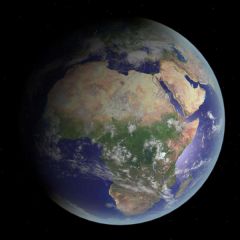Earth
Earth is the third planet from the Sun and is the only body known to have life. It is one of the four 'rocky' planets, the others are Mercury, Venus, and Mars. The Moon is the only natural satellite orbiting the earth.
The earth is modeled in Orbiter as an oblate spheroid, its mean diameter is 6371.01 km, equatorial radius 6378.165 km. The sidereal day is 86164.092 seconds, the obliquity is 23.439291°.
The stock Orbiter includes 35 bases, some of which include details such as runways, landing pads, buildings, etc, some only include a marker to depict its location.
Natural satellites
See also
- Addons for Earth
- Earth at Wikipedia
External links
Earth at Wikipedia
| edit The Solar System | |
|---|---|
| Central star |
Sun (Sol) |
| Planets |
Mercury - Venus - Earth - Mars - Jupiter - Saturn - Uranus - Neptune |
| Natural satellites |
Moon - Phobos - Deimos - Io - Europa - Ganymede - Titan - more... |
| Add-ons |
Planets - Dwarf Planets - Small objects - Natural satellites - Alternative star systems |
 | This article, about a planet, is a stub. You can help Orbiterwiki by expanding it.
|
